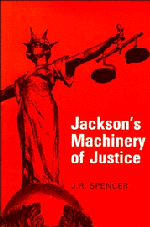Book contents
- Frontmatter
- Contents
- Acknowledgements
- List of figures
- List of tables
- Preface
- Preface to the first edition of ‘The Machinery of Justice in England’
- Abbreviations
- I Historical introduction
- II Civil jurisdiction
- III Tribunals
- IV Criminal jurisdiction
- V The personnel of the law
- VI The European dimension
- 35 The European Convention on Human Rights
- 36 The European Economic Community
- 37 The impact of Europe on the English legal system
- VII The cost of the law
- VIII Law Reform
- Appendix A The Report of the Civil Justice Review
- Table of Cases cited
- Table of Statutes cited
- Table of Stationery Office publications cited
- Index
36 - The European Economic Community
Published online by Cambridge University Press: 10 January 2011
- Frontmatter
- Contents
- Acknowledgements
- List of figures
- List of tables
- Preface
- Preface to the first edition of ‘The Machinery of Justice in England’
- Abbreviations
- I Historical introduction
- II Civil jurisdiction
- III Tribunals
- IV Criminal jurisdiction
- V The personnel of the law
- VI The European dimension
- 35 The European Convention on Human Rights
- 36 The European Economic Community
- 37 The impact of Europe on the English legal system
- VII The cost of the law
- VIII Law Reform
- Appendix A The Report of the Civil Justice Review
- Table of Cases cited
- Table of Statutes cited
- Table of Stationery Office publications cited
- Index
Summary
The second big change is the consequence of Great Britain's joining the EEC on 1 January 1973. This was formally accomplished by Parliament enacting the European Communities Act 1972. This incorporates into the law of the United Kingdom as much of the EEC Treaty as is required by that Treaty to be given direct effect in the law of the nation states. One of the articles which was given immediate effect in this way was Article 177, which provides that matters of EEC law arising in the course of litigation in the United Kingdom always may be, and sometimes must be referred to the European Court at Brussels for a ruling. All existing United Kingdom law contrary to the provisions of the Treaty are repealed by the Act, which also delegates to the legislative organs of the EEC the power to make, within the scope of the Treaty, laws which may then have force in Britain. Thus it is possible for laws to be made in Brussels regulating in Great Britain agriculture, the movement of goods, free trade, unfair trade competition, social security, the movement of workers and a number of other matters, even to the extent of repealing existing British statute and common law.
- Type
- Chapter
- Information
- Jackson's Machinery of Justice , pp. 434 - 439Publisher: Cambridge University PressPrint publication year: 1989

